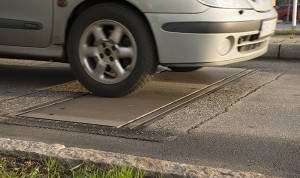More alternatives are emerging that lack the downsides of permanent speed bumps. VTI has examined the types of available dynamic speed bumps and assessed which could suit the Nordic climate.
An alternative speed bump can be either passively or actively dynamic. Passively dynamic speed bumps are those that, for example, are collapsed by heavy vehicles but do not use any electronics. One variant allows buses and emergency vehicles to pass unhindered as the air inflating the speed bump is forced out via a safety valve by heavier vehicles. Drivers of normal cars, however, will experience the same level of discomfort as with solid speed bumps.
“The drawback of passively dynamic speed bumps is that regular cars are forced to reduce their speed to far below the posted limit, even on roads where the posted limit is 30 km/h, which results in driving behaviour in which the driver reaccelerates the car to the posted speed limit or perhaps even higher immediately upon crossing the speed bump. Driving this way produces more noise and emissions and reduces driver comfort”, says VTI researcher Omar Bagdadi.
Actively dynamic speed bumps are those that can be activated electronically, for example, by radar or induction coils that sense the type of vehicle approaching or the speed at which the vehicle is moving.
One example is a speed bump that deploys a flap in the ground, creating a resistant edge over which the vehicle drives if it is going too fast. A road sign notifies the drivers before the speed bump if their speed is too high. The networked control system enables a degree of control over the permissible speeds at certain times of day/week and can be equipped with a receiver to enable special vehicles, such as ambulances and police vehicles, to pass unhindered regardless of their speed.
“These speed bumps are designed to make it possible to maintain a heavy traffic flow at a uniform speed on a stretch of road. These speed bumps require neither cars nor heavy vehicles to slow down to below the posted speed limit in order to pass unhindered”, says Bagdadi.
The report identifies few documented evaluations of alternative speed bumps. The researchers confirm that both passively and actively dynamic speed bumps are of interest and could replace or supplement traditional solid speed bumps in Sweden.
Report:
VTI Report 823: Dynamic speed humps. A literature study
Authors: Omar Bagdadi, Christopher Patten.
Link to report (in Swedish with English summary).
 Contact: Contact:Omar Bagdadi omar.bagdadi@vti.se VTI, Sweden |







Follow us: